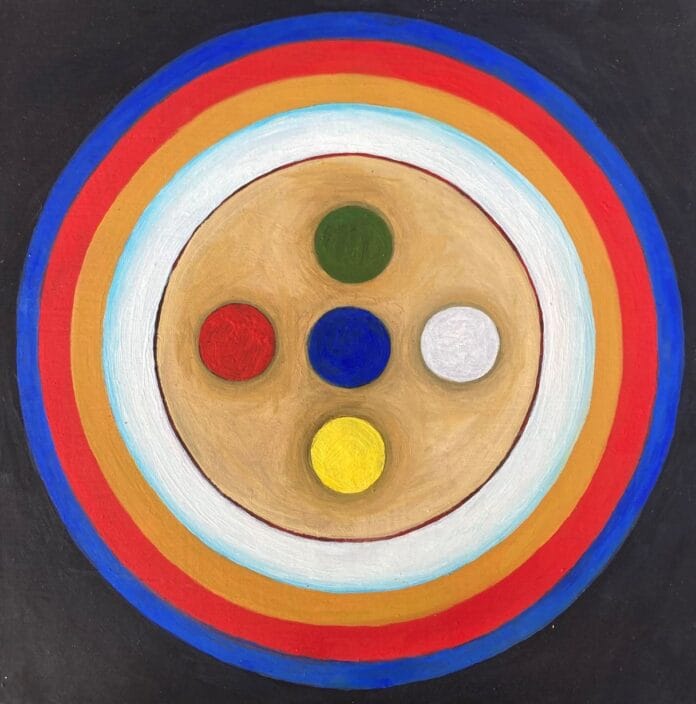Roshan Houshmand is an Iranian-American artist and educator whose multicultural upbringing deeply informs her art. Born in the Philippines in 1961, she spent her formative years in both the Philippines and Iran before moving to the United States in 1978. Her academic path reflects a commitment to both intellectual and artistic rigor: she earned her BA from Bennington College in Vermont, followed by an MA and MFA from Rosary College Graduate School of Fine Arts in Florence, Italy.
Her journey didn’t stop there. Houshmand later studied with Julio Alpuy of the Joaquin Torres Garcia School of Universal Constructivism in New York City, further grounding her practice in modernist abstraction and a universalist vision. Beginning in 2016, she regularly traveled to India and Nepal, immersing herself in the study of sacred Tibetan Buddhist thangka painting, notably at Shechen Monastery’s Tsering Art School in Nepal. Over the years, her paintings have received critical acclaim, grants, and awards, and are exhibited and collected internationally.
Artistic Philosophy: From the Personal to the Universal
Roshan Houshmand’s work is both deeply personal and broadly universal. Her vivid, textured paintings reflect a visual language that is at once autobiographical and spiritual. Having lived and traveled across Europe, Asia, the Middle East, and the Americas, her work carries a sense of global consciousness. Central to her artistic expression is the philosophy and discipline of Tibetan Buddhism, which informs not only her subject matter but also her process and purpose.
Houshmand’s work is not merely decorative or narrative—it is contemplative. Each piece functions as a vessel for transformation, reflection, and healing. Through art, she bridges cultures and philosophies, uniting East and West, emotion and intellect, grief and hope.
The Mandala Series: Art as a Healing Ritual
Roshan’s fascination with mandalas began in 2012 when a Lama suggested she copy a thangka painting to deepen her meditation and visualization practice. Though she initially struggled with the discipline, a workshop on mandalas revealed a new esoteric dimension to her practice. This discovery catalyzed her journey to Dharamsala, India in 2015, and then to Boudhanath, Nepal, where she studied at Tsering Art School.
The training was intense—seven hours a day of drawing and painting traditional motifs under strict supervision. Yet it was within this repetition and rigor that Roshan began to grasp the mandala not just as a symbol, but as a practice of the mind. She embraced the patience, precision, and presence required, and brought this sacred focus back to her studio in New York.
Then in 2020, her world changed irrevocably. The sudden loss of her only child, Ben, plunged her into unimaginable grief. It was during this time that the mandala became more than spiritual practice—it became survival. “The circle chose me,” she wrote. “Any other expression was unsustainable.”
Circle as Sanctuary: Process and Form
Roshan’s mandalas emerged as a daily ritual—each painting a way to endure the day, to find stillness amid pain, to create order in chaos. From these moments of suffering, over a hundred mandala paintings were born. These works vary in scale and technique: small, intimate 8×8 inch mandalas painted on cradled wood panels, and larger canvases alive with poured oils, layered stains, and time-marked transparencies.
For Houshmand, the circle became a space of refuge. These paintings are not strict representations of traditional Tibetan mandalas, but deeply personal interpretations inspired by her training. Her larger pieces reveal a visible, physical process—paint drips, transparent washes, and instinctive color choices speak to the passage of time and the healing nature of repetition.
Mandala as Medicine: Psychological and Spiritual Impact
Scientific studies and spiritual teachings both acknowledge the healing power of mandalas. Figures like Carl Jung and Alexander Berzin have written about their therapeutic properties—how they ease depression, reduce stress, boost immunity, and promote mental clarity. From the Buddhist perspective, mandalas are tools for cultivating positive qualities and focusing the mind.
For Roshan, these paintings became a lifeline. Grief, isolation due to COVID, and physical exhaustion were met each day with the act of painting. The mandalas helped reassemble her broken pieces. As she notes, “Each painting was a steppingstone back to life.” The formless layers of her larger works echo the Buddhist concept of bardos—transitional states between death and rebirth—suggesting the mandala is as much about passage as presence.
An Offering to Others
Though born from personal tragedy, Roshan’s mandala series offers light to others. Her hope is that those who view or live with her work will find a sanctuary, a quiet resonance, or even a moment of healing. “They were, to me, gifts from the universe,” she writes, “and I share them with the aspiration that others might find sanctuary in them as well.”
Through these works, Roshan Houshmand embodies the bodhisattva spirit—transforming pain into compassion, and art into service. The mandala, with no beginning and no end, becomes a symbol of impermanence, but also of infinite possibility.


